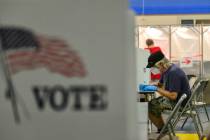STEVE SEBELIUS: Tax-free bonds turn Vegas-to-Victorville train dream into reality
After decades of talk, planning and dashed dreams, it appears the long-anticipated high-speed train between Las Vegas and Victorville, California, is finally going to happen.
Thanks in part to the states of Nevada and California.
Using federally granted authority, the two states were able to allow Brightline, the private company behind the train, to issue tax-free bonds to build it. So-called private activity bonds are generally used to build affordable housing and infrastructure projects.
Although the state Board of Finance meeting on July 24 that approved Nevada’s $200 million share of the project lasted less than 30 minutes, the process that ended there started decades ago.
Both Gov. Steve Sisolak and Clark County Commissioner Michael Naft stressed that no taxpayer dollars are being used to support the train, and that is true. State Treasurer Zach Conine added that, even if the train project falters, Nevada would not be on the hook for a dime.
But it’s equally true that, without the state-sanctioned bonds, the project would be much more expensive to build and a much riskier proposition for investors.
It’s also true that using $200 million of the state’s bond cap for the train means that much less for other projects, although Conine insists that all affordable housing projects on the books were already financed. “No affordable housing was sacrificed for the project at all,” he said.
In fact, the train’s developers are planning to build some affordable housing of their own on the 110-acre site where their train station will be built on Las Vegas Boulevard near Warm Springs Road. And Christine Hess, executive director of the Nevada Housing Coalition, testified in favor of the project at the Board of Finance, although she asked that the majority of the state’s 2021 bond allocation be used for affordable housing.
Housing is going to be a pressing need in Nevada as the fallout from the coronavirus business shutdown expands and restrictions on evictions are loosened.
So what does Nevada get out of the deal? If the grand plans come to fruition, it will get tourists.
Anybody who has tried to leave L.A. or San Diego for a weekend in Las Vegas on a Friday and return home on a Sunday knows the hell that is Interstate 15, which narrows to a traffic-choked two lanes for the 112 miles between Barstow and Primm. Traffic backlogs can turn a four-hour trip into a hellish eight- to 10-hour commute.
Ironically enough, building the high speed train is more likely than political leaders in California spending their state’s money to widen I-15 in San Bernardino County. And although adding another travel lane improves traffic flow, it eventually would be clogged, too.
“You can’t just always build concrete,” says Ben Porritt, senior vice president of corporate affairs at Brightline, the company building the train.
Plus, he says, people want to use their cellphones or laptops while driving, especially on long drives, but laws prohibit drivers from doing so in Nevada and California. He added that international visitors are used to train travel at home and expect it abroad. “So many trends point to high-speed rail,” he says.
Yes, but … Victorville? The jokes virtually write themselves.
Train proponents, however, have always said Victorville isn’t the final destination. They have always dreamed of a link to Palmdale, in the high desert, one of the planned stops on California’s planned intrastate high-speed rail system, which ultimately may connect the Golden State’s biggest cities.
And, Porritt says, the train’s backers have recently begun exploring a descent along the Cajon Pass into Rancho Cucamonga. That city is a stop on Southern California’s Metrolink system, commuter trains that run into the heart of Los Angeles. “From our perspective, all of these forms of transportation work best together,” Porritt says. “All of these transportation systems complement each other.”
There are still big hurdles: Descending the Cajon Pass at speed is difficult, as the terrain doesn’t lend itself easily to rail lines. And the California high-speed system is behind schedule and over budget, which could mean a vast system with a Palmdale stop is more hope than reality.
Then again, that’s what they said for years about the train across the desert, and for years it was mostly just a mirage shimmering in the desert heat. But now, with a big boost from California and Nevada, it seems that hope is about to become a reality.
Contact Steve Sebelius at SSebelius@reviewjournal.com or 702-383-0253. Follow @SteveSebelius on Twitter.























